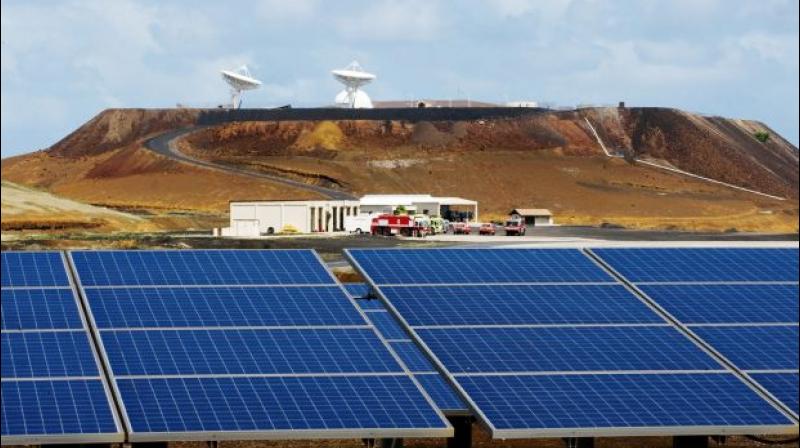
Every summer, as the mercury rises in India, the demand for electricity spikes dramatically and sets new records. This year, the peak power demand on May 29 rose to a record 250 gigawatts (GW) following an exceptionally harsh summer with prolonged heatwaves in most parts of the country. By 2030, this peak demand is projected to cross 400 GW.
The latest World Energy Outlook from International Energy Agency (IEA) highlights that India will experience the largest energy demand growth of any country or region globally over the next three decades. Just the electricity demand to power air conditioners is projected to increase nine-fold by 2050, surpassing the entire total power consumption of the African continent currently, says the report.
Meeting this demand while also fulfilling India’s Net Zero commitments, and with a focus on climate change and sustainability, will necessitate our power generation to quickly transition to renewable or clean energy.
India’s renewable energy (RE) generation capacity, including solar and wind power generation, has grown 290% in the last 8 years to 114 GW, and the government aims to grow it to 500 GW by 2030. 1 However, RE faces a significant gap between the installed capacity and its actual contribution to electricity supplied to end-users.
Despite accounting for a third of the country’s installed power-generating capacity in the last financial year, RE still only contributes to about 12% of the total electricity supply as per analysts. 2 In contrast, thermal power still dominates the scene with close to 80% of daily demand being met through coal-run power plants. This disparity highlights the need for improved integration and utilisation of RE sources.
What is stopping this integration is the unpredictability of renewable power generation on account of its heavy dependence on factors like wind and sunlight. For example, solar power units do not generate any power during night. This is the major reason why plant load factor (PLF) for renewable energy continues to be in the range of 16-18%.
If only this power generated could be stored safely and efficiently and fed back to the grid in a controlled and predictable manner, its actual utilisation could rise significantly, possibly in direct proportion to the imminent growth in installed capacity. As it turns out, energy storage technologies have improved dramatically in recent years and we finally have a solution to store all the renewable power generated, appropriately named as Battery Energy Storage Systems (BESS).
Modern BESS, also known as Battery Storage Power Stations (BSPS), come in various sizes and can fulfill the energy storage needs of industrial plants, residential or commercial complexes, and national grids. BESS with 10 MW or higher capacities are typically targeted for grid storage. Earlier this year, India added its largest BESS in Chhattisgarh with 152.325 MWh installed capacity. In contrast, the world’s largest BESS in California, US, has 750 MW capacity.
BESS play a pivotal role in addressing the intermittency and reliability challenges associated with renewable energy, enabling a more stable and resilient power grid. By ensuring maximum utilisation of installed RE capacity, they can dramatically help reduce the reliance on thermal power, in turn accelerating the world’s transition towards clean energy.
This also explains the explosive growth in BESS adoption worldwide. The global energy storage market grew nearly three times in 2023 with a record 45 gigawatts new capacity added. By 2030, the cumulative installed capacity is predicted to reach 650 GW, largely on account of falling lithium-ion battery prices, and government subsidies and policies in many countries promoting energy storage and pairing it with large-scale wind and solar power projects.
While China leads the world with 35GW installed energy storage capacity, India, with less than 200 MWh installed capacity, is likely to remain a marginal player in comparison, unless significant policy interventions are made quickly.
Still, India recently became a member of the Battery Energy Storage Systems (BESS) Consortium and has pledged to securing 5 GW of BESS commitments by the end of 2024. 7 NTPC and Solar Energy Corporation of India (SECI) recently invited proposals for aggregate output and capacity of 250MW/500MWh and 1,000MW/2,000MWh respectively. 89 Another private company recently announced the construction of 1 GWh BESS in Rajasthan.
Meanwhile, a 2023 report by Global Energy Alliance for People and Planet (GEAPP, the organization behind BESS Consortium) and RMI noted that India will need 42 GW (208 GWh) of BESS capacity to integrate 392 GW of variable RE (100 GW of wind and 292 GW of solar) by 2030.
Newspaper reports last year said the India is developing a subsidy program worth $2.5 billion for production of grid-scale batteries, but there has been no formal announcement afterwards. 11 In September 2023, the figure was revised to $452 million worth of incentives. Furthermore, whether India should adopt the Chinese policy of compulsory pairing of BESS with all new RE power units is a moot point.
As a country committed to transitioning to clean energy, India has made a promising start in accelerating its renewable power generation capacity addition in recent years. A similar concerted action is needed to augment the country’s energy storage capacity in order to actually put the RE generation capacity to maximum use. Only then we as a country can make a sizeable dent in our heavy dependence on thermal power and aspire to leave a better planet for the future generations.
This article is written by Aayush Goyal, MD at RCRS Innovations Limited (RCRSIL)
